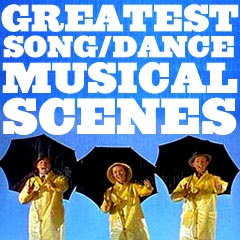
|
|
| I - J | |||||||||||
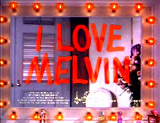
|
I Love Melvin (1953) A lesser-known and unheralded MGM musical from the heyday of musicals in the 1950s, director Don Weis' film featured a reteaming of two of the three star performers from Singin' in the Rain (1952) - Debbie Reynolds (as ambitious Broadway musical chorus girl and aspiring actress Judy Leroy/Schneider) and Donald O'Connor (as lowly assistant Melvin Hoover to ornery LOOK Magazine photographer Mergo (Jim Backus)). In the opening to the title sequence, an unidentified backstage performer, in front of her marquee-styled mirrror, inscribed the film's title - in bright red lipstick - on the mirror. The opening number was a purple feathered-costumed performance by Judy of "A Lady Loves (to Love)" with a black-top-hatted male chorus. It was revealed to be a daydream when she was shaken awake by her mother ("Come on, get up, it's late!"). Shortly later, the musical's two eventual lovers - both daydreamers - bumped or collided into each other in Central Park after walking along two sides of the same tall hedge. Judy and Melvin sang the song "We Have Never Met, as Yet" together. In Judy's theatre show, Quarterback Kelly, there was an amazing, acrobatic sequence of "Saturday Afternoon Before the Game" (Reynolds portrayed the inflated, light brown pigskin football!). After meeting again, Melvin's exaggerated boasting and flattering claims caused Judy to believe he was a famous magazine photographer who would shoot her for a two-page spread and possibly put her on the magazine's cover. Judy and Melvin performed a deceptively-simple dance duet "Where Did You Learn To Dance?" in Judy's living room after he had taken photographs of her. He wanted her in various poses to show her backstage and city life - with shots of Judy vacuuming, ironing, washing her hair, and visiting NYC sites. One of the best scenes was Melvin's roller-skating (and tap-dancing) act in a park gazebo (and his swinging from lamp posts and stomping - in homage to Gene Kelly in Singin' in the Rain) to entertain Judy's younger sister Clarabelle Schneider (Noreen Corcoran) who had just finished singing "Life Has Its Funny Little Ups and Downs" with him. Melvin also experienced a crazy romp through the travel agency sections of the Look Magazine offices while singing "I Wanna Wander" - and entered into various locales and personas (via changing backdrops, props and quick costume changes). Judy also performed in the "If I Had a Million Dollars" sequence - a fanciful dance with a trio of Gene Kellys and Fred Astaires - and afterwards imagined that she was receiving an Oscar award - another dream. In the wish-fulfillment ending after Melvin was dejected, ashamed, and had run away and abandoned his job, he disappeared for three weeks, and awoke back in Central Park on one of the benches; he discovered that Judy was on the cover of Look Magazine and an inside article was written about him, beseeching him to come back: "Melvin Where Are You?" - the happy conclusion was orchestrated by Judy to identify him, entice him to come out of hiding, and bring them together. |
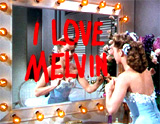 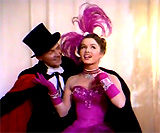 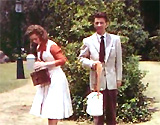 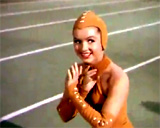  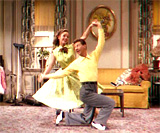 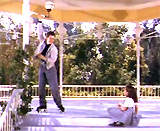 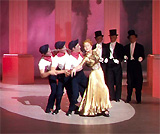 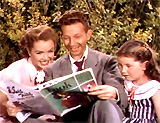
|
|||||||||
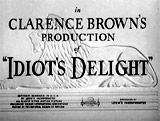
|
Idiot's Delight (1939) Clark Gable made his musical debut in this MGM film (a version of Robert Sherwood's Pulitzer Prize-winning 1936 play) as American entertainer Harry Van. It was notable as a film Gable made in the same year as Gone With the Wind (1939), and Gable's only film in which he sang and danced. Gable performed a slightly inferior song-dance rendition of Irving Berlin's Puttin' on the Ritz (pictured), with a straw hat, white cane and bevy of six dancing girls (his traveling all-girl troupe of "Les Blondes") behind him. |

|
|||||||||
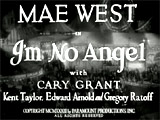
|
Mae West was headlined as a floozy lady lion tamer in a small-town circus act named Tira in this bawdy comedy classic. Quotable wisecracks and one-liners, and racy double entendres in her promiscuous dialogue, suggestive songs and body language added to the film's comical plot. In an early scene, Tira shook down an admiring, visiting suitor in his hotel room, a Chump named Ernest Brown (Wm. B. Davidson). After learning he was from Dallas, she played a record with the song: No One Loves Me Like That Dallas Man (originally titled No One Does It Like That Dallas Man) (pictured), choosing the appropriate city title from among similar records for Frisco and Memphis Men. The song's racy lyrics had a number of suggestive lines: "Why, brother, he's a wild horse trainer, With a special whip - Gals you'll go insaner When he gets you in his grip..." She sang and danced seductively in front of him as he warmed up to her: "You're certainly givin' me the time of my life, baby" with her quick reply: "Don't say givin'. I don't like that word givin'." She then gave him a long kiss. |
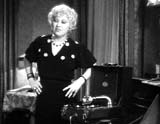
|
|||||||||
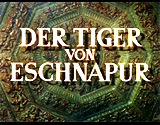 The Tiger of Eschnapur (1959, W.Germ/Fr./It.)  The Indian Tomb (1959, W. Germ/Fr./It.) |
The Tiger of Eschnapur (1959, W.Germ/Fr./It.) (aka
Der Tiger von Eschnapur) Director Fritz Lang's Technicolored romantic adventure drama - a two-part Indian epic composed of The Tiger of Eschnapur (1959, W.Germ./Fr./It.) (aka Der Tiger von Eschnapur) and The Indian Tomb (1959, W.Germ./Fr./It.) (aka Das Indische Grabmal), were both edited into American-International's 92-minute Journey to the Lost City (1960) for its US release - a comic-bookish precursor to the Indiana Jones franchise. The main feature of both films was an erotic temple dance performed by Debra Paget as Seetha, a beautiful, half-white (Irish) handmaiden and sacred temple dancer - she was the love-object of two competing males in the mystical province of Eschnapur: German architect Harold Berger (Paul Hubschmid) and the local wicked, tyrannical, aristocratic Maharaja Chandra (Walther Reyer). The screenshots for the two lengthy dance sequences were derived from the original films, not the 1960 compilation. The dance scenes in the 1960 compilation were heavily edited and censored by the Hays Office. In the first film, she descended stairs, wearing a gold headdress, bangles, and a gold-colored dance costume that bared her belly. She performed a ritualistic dance in front of sacred priests and the giant stone statue of the goddess Shiva with voluminous breasts. At one point, she writhed her body in the huge outstretched right hand palm of the statue.
In the second film, Seetha performed a much sexier, mesmerizing, sinuous, near-naked (stripteasing), exotic temple snake dance (in a three-piece, glued-on, strategically-placed, scanty jewel-encrusted white bikini) to prove her innocence before temple priests in a cave - also directly in front of Shiva - an enormous, half-naked stone temple goddess. The dance began when Seetha moved her hands from inside her blue robe, in front of a gigantic hooded cobra (obviously fake) - pretending them to be snake heads, with two green rings (snake eyes) on each of her hands; after discarding her robe, she attempted to provocatively charm the ropy, long phallic-shaped creature with her entrancing dance; at the conclusion of her dance, she tripped and before being bitten by the disapproving cobra, Chandra stepped in and crushed the snake. |
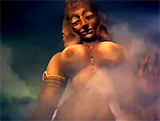 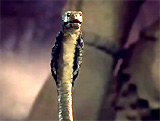 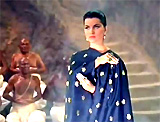 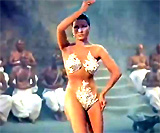 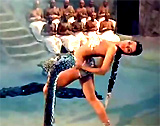 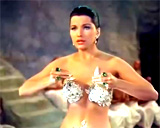
The Indian Tomb (1959, W. Germ/Fr./It.) |
|||||||||
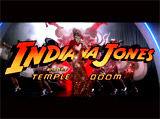
|
Indiana Jones and the Temple of Doom (1984) The brilliant, incongruous opening credits to this Indiana Jones action-adventure film included a musical scene in crime lord Lao Che's "Obi-wan" Night Club in Shanghai China of 1935. The American singer/dancer was Wilhelmina "Willie" Scott (Kate Capshaw) singing (in Chinese!) the 1930's hit song Anything Goes (pictured):
The number blossomed into a full-fledged Busby Berkeley-styled production number with curly blonde-wigged, hatted chorines in silver rhinestone-studded outfits tap-dancing in unison, performing splits, and pulling out red-handkerchiefs that transformed into large billowing red banners of cloth. |
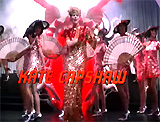 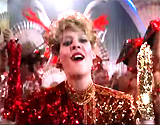 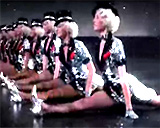
|
|||||||||
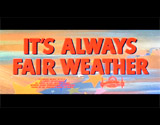
|
It's Always Fair Weather (1955) This Cinemascopic, widescreen MGM musical (a Betty Comden and Adolph Green collaboration that was co-directed by Gene Kelly and Stanley Donen) reprised the story line of On the Town (1949) (although ten years later and more cynical). Its male stars Gene Kelly (as Ted Riley), Michael Kidd (the famed choreographer in his first on-screen role, as Angie Valentine) and Dan Dailey (as Doug Hallerton) portrayed wartime buddies who performed an amazing opening dance sequence - a trash-can-lid ballet (pictured). [Note: This routine was later recreated by the Yes/No Group and their hit musical STOMP.] Also memorable was Kelly's solo musical number I Like Myself (pictured) in which Kelly roller-skated (and tap-danced on the skates) on a New York street sidewalk. The musical also featured Cyd Charisse (as advertising girl Jackie Leighton, wearing a green dress) solo dancing to Baby, You Knock Me Out (pictured) with Stillman's Gym boxers. |
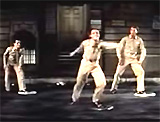 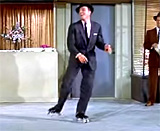 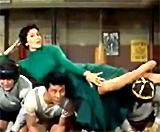
|
|||||||||

|
In this MGM production, the title song and production number was the memorable, wonderfully-choreographed Jailhouse Rock (pictured twice), with rebellious behind-bars Vince Everett (Elvis Presley in his first major dramatic singing role), musicians and dancers dressed in black leather jackets and striped prison uniforms. The other memorable numbers included:
There were also two tender ballads:
|
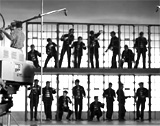 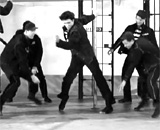 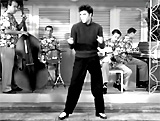 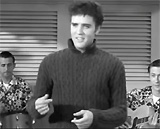 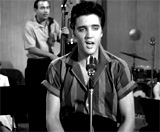 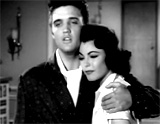
|
|||||||||
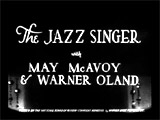
|
This Warner Brothers film by director Alan Crosland - lauded with an honorary statuette at the Academy Awards as "the pioneer outstanding talking picture, which has revolutionized the industry." In actual fact, more audiences saw the film as a silent film rather than as a talkie, due to the non-proliferation of Vitaphone sound systems in theatres. The landmark film starred singer Al Jolson as cantor's son Jakie Rabinowitz, who chose a career as a singer (with new name Jack Robin) and alienated his Jewish father, while romancing Mary Dale (May McAvoy). The musical included singer Al Jolson's two most memorable numbers:
Also memorable was Jolson's curtain-closing blackface make-up performance of My Mammy (pictured twice) - dedicated to his mother seated in the Winter Garden Theater audience when he was down on one knee for the final chorus to her, flinging his arms out toward her and the world:
|
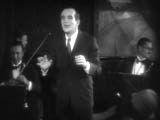 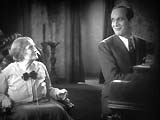 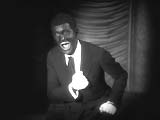 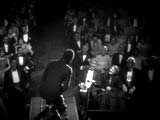
|
|||||||||
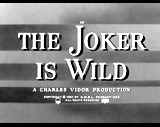
|
The Joker Is Wild (1957) (aka All the Way)
Director Charles Vidor's bittersweet and gloomy musical showbiz drama was a biographical film (based on Art Cohn's account) about a legendary figure in 1920s Chicago - successful night-club (speakeasy) entertainer and singer Joe E. Lewis (Frank Sinatra). After having his vocal cords damaged by Al Capone's enforcer-mob for refusing to join him, he recuperated and became a popular sharp-tongued comedian, performing alongside Sophie Tucker (as herself). A self-destructive streak, gambling and alcoholism threatened to sideline his career and failed marriage with chorus girl-dancer Martha Stewart (Mitzi Gaynor), and an ill-fated romance with wealthy socialite-debutante Letty Page (Jeanne Crain). The movie was the Oscar winner for Best Original Song All the Way (pictured) (music by Jimmy Van Heusen and lyrics by Sammy Cahn) (the film's sole nomination).
|

|
|||||||||
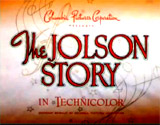 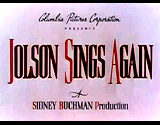 |
The Jolson Story (1946) and Jolson Sings Again (1949) These musical films made up a two-part biopic of the famed show-biz performer Al Jolson (played by Larry Parks in both films), with Jolson's own voice effectively dubbed over the voice of the actor singing many of his favorite tunes. The first immensely-popular Technicolored film The Jolson Story (1946), received six Academy Awards nominations, including Best Actor (Larry Parks) and Best Supporting Actor (William Demarest), but won only for Best Musical Scoring and Best Sound Recording. The second film, the sequel Jolson Sings Again (1949), was directed by Henry Levin, replacing Alfred E. Green. It was nominated for three Academy Awards: Best Story & Screenplay, Best Color Cinematography, and Best Scoring of a Musical Picture. In Jolson Sings Again, Jolson (Larry Parks) agreed to have his life story committed to film in a major Columbia Pictures film - the first film in fact (a "film within a film") -- The Jolson Story. In a bizarre, remarkable scene, Al Jolson (Larry Parks) watched a portion of the film being made of his life. In the film screening room during the viewing of a segment of Jolson singing Toot Toot Tootsie in blackface, Jolson kept exclaiming that he loved the impersonating actor: "What's going on here? Who's that?...Who's the guy there?...Wonderful! Who was that?" Afterwards, he was introduced to "a young fellow named Larry Parks" - (Larry Parks himself) in a clever split-screen shot - causing a few double-takes of glances! |
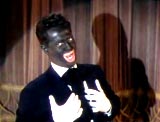 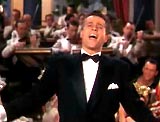 The Jolson Story (1946) 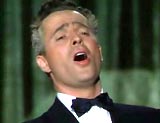  Jolson Sings Again (1949) |
|||||||||
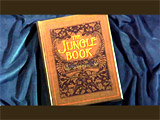
|
The Jungle Book (1967) This was a high-spirited animated Disney musical, loosely based upon the tales of Rudyard Kipling. It included:
|
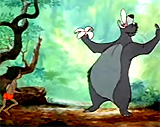 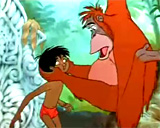
|
|||||||||
(alphabetical by film title) Introduction | A-1 | A-2 | B-1 | B-2 | B-3 | C-1 | C-2 | D-1 | D-2 | E | F-1 | F-2 | G-1 | G-2 H-1 | H-2 | I-J | K | L-1 | L-2 | M-1 | M-2 | N-O | P-1 | P-2 | R-1 | R-2 | S-1 | S-2 | S-3 | T | U-V | W | X-Z |